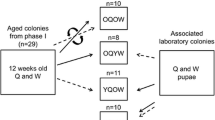Summary
The effect of workers size frequency distribution on colony development was studied in 12 young colonies ofB. terrestris. By replacing the original workers with workers of determined size, colonies constituting small, large or mixed size nursing workers were created. The nursing workers size frequency distribution did not influence the average size of the newly emerged workers, nor their size frequency distribution. In contrast, the number of emerging workers and number of egg cells constructed by the queen in colonies with large workers were higher than in colonies with small workers. The small number of emerging workers is explained by prolonged duration of larval time in response to sub-optimal feeding in colonies of small workers. The higher number of egg cells constructed by the queens is supposed to be in response to the number of new cocoons available, or to better condition of the brood.
Similar content being viewed by others
References
Brian, A. D., 1952. Division of labor and foraging inBombus agrorum.J. Anim. Ecol. 21:223–240.
Duchateau, M. J. and H. H. W. Velthuis, 1988. Development and reproductive strategies inBombus terrestris colonies.Behaviour. 107:186–207.
Hölldobler, B. and E. O. Wilson, 1990.The ants. The Belknap Press of Harvard University Press. Cambridge Mass. 732 pp.
Michener, C. D., 1974.The social behaviour of the bees. Harvard University Press, Cambridge Mass. 404 pp.
Oster, G. F. and E. O. Wilson, 1978.Cast and ecology in the social insects. Princton University Press, Princton, New Jersey, 352 pp.
Plowright, R. C. and S. C. Jay, 1968. Caste differentiation in bumblebees (Bombus Latr.: Hym.) I. The determination of female size.Ins. Soc. 15:171–192.
Sutcliffe, G. H. and R. C. Plowright, 1988. The effects of food supply on adult size in the bumblebeeBombus terricola.Can. Entomol. 120:1051–1058.
Sutcliffe, G. H. and R. C. Plowright, 1990. The effects of pollenavailability on development time in the bumble beeBombus terricola K. (Hymenoptera: Apidae).Can. J. Zool. 68:1120–1123.
Wheeler, D. E. and H. F. Nijhout, 1984. Soldier determination inPheidole bicarinata: Inhibition by adult soldiers.J. Insect Physiol. 30:127–135.
Wilson, E. O., 1971.The insect societies. Harvard University Press, Cambridge Mass. 548 pp.
Author information
Authors and Affiliations
Rights and permissions
About this article
Cite this article
Cnaani, J., Hefetz, A. The effect of workers size frequency distribution on colony development inBombus terrestris . Ins. Soc 41, 301–307 (1994). https://doi.org/10.1007/BF01242301
Received:
Revised:
Accepted:
Issue Date:
DOI: https://doi.org/10.1007/BF01242301




